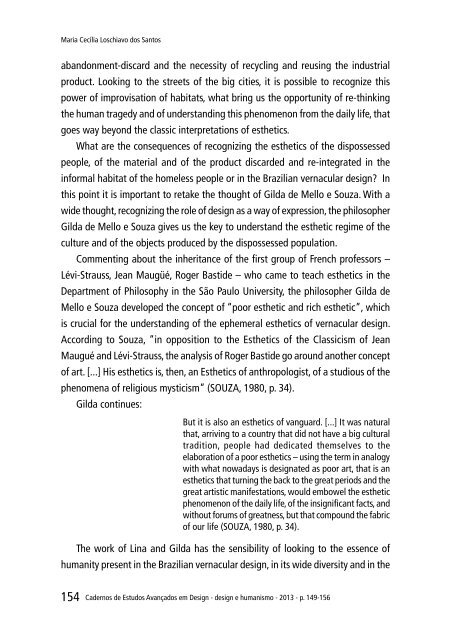o_19po8js951tvs1r0t1r8s4bb1vpla.pdf
You also want an ePaper? Increase the reach of your titles
YUMPU automatically turns print PDFs into web optimized ePapers that Google loves.
Maria Cecília Loschiavo dos Santos<br />
abandonment-discard and the necessity of recycling and reusing the industrial<br />
product. Looking to the streets of the big cities, it is possible to recognize this<br />
power of improvisation of habitats, what bring us the opportunity of re-thinking<br />
the human tragedy and of understanding this phenomenon from the daily life, that<br />
goes way beyond the classic interpretations of esthetics.<br />
What are the consequences of recognizing the esthetics of the dispossessed<br />
people, of the material and of the product discarded and re-integrated in the<br />
informal habitat of the homeless people or in the Brazilian vernacular design? In<br />
this point it is important to retake the thought of Gilda de Mello e Souza. With a<br />
wide thought, recognizing the role of design as a way of expression, the philosopher<br />
Gilda de Mello e Souza gives us the key to understand the esthetic regime of the<br />
culture and of the objects produced by the dispossessed population.<br />
Commenting about the inheritance of the first group of French professors –<br />
Lévi-Strauss, Jean Maugüé, Roger Bastide – who came to teach esthetics in the<br />
Department of Philosophy in the São Paulo University, the philosopher Gilda de<br />
Mello e Souza developed the concept of “poor esthetic and rich esthetic”, which<br />
is crucial for the understanding of the ephemeral esthetics of vernacular design.<br />
According to Souza, “in opposition to the Esthetics of the Classicism of Jean<br />
Maugué and Lévi-Strauss, the analysis of Roger Bastide go around another concept<br />
of art. [...] His esthetics is, then, an Esthetics of anthropologist, of a studious of the<br />
phenomena of religious mysticism” (SOUZA, 1980, p. 34).<br />
Gilda continues:<br />
But it is also an esthetics of vanguard. [...] It was natural<br />
that, arriving to a country that did not have a big cultural<br />
tradition, people had dedicated themselves to the<br />
elaboration of a poor esthetics – using the term in analogy<br />
with what nowadays is designated as poor art, that is an<br />
esthetics that turning the back to the great periods and the<br />
great artistic manifestations, would embowel the esthetic<br />
phenomenon of the daily life, of the insignificant facts, and<br />
without forums of greatness, but that compound the fabric<br />
of our life (SOUZA, 1980, p. 34).<br />
The work of Lina and Gilda has the sensibility of looking to the essence of<br />
humanity present in the Brazilian vernacular design, in its wide diversity and in the<br />
154<br />
Cadernos de Estudos Avançados em Design - design e humanismo - 2013 - p. 149-156



